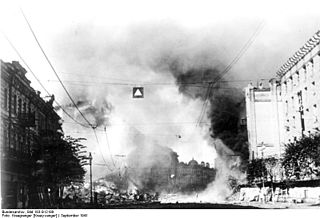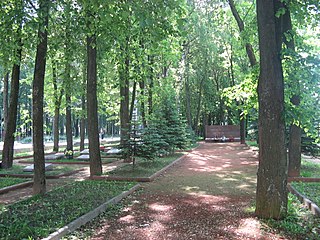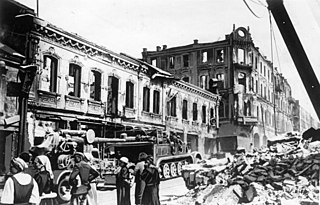
The Battle of Moscow was a military campaign that consisted of two periods of strategically significant fighting on a 600 km (370 mi) sector of the Eastern Front during World War II, between October 1941 and January 1942. The Soviet defensive effort frustrated Hitler's attack on Moscow, the capital and largest city of the Soviet Union. Moscow was one of the primary military and political objectives for Axis forces in their invasion of the Soviet Union.

The First Battle of Kiev was the German name for the major battle that resulted in an encirclement of Soviet troops in the vicinity of Kiev during World War II, the capital and most populous city of the Ukrainian Soviet Socialist Republic. This encirclement is the largest encirclement in the history of warfare by number of troops. The battle occurred from 7 July to 26 September 1941 as part of Operation Barbarossa, the Axis invasion of the Soviet Union.

The first Battle of Smolensk was a battle during the second phase of Operation Barbarossa, the Axis invasion of the Soviet Union, in World War II. It was fought around the city of Smolensk between 10 July and 10 September 1941, about 400 km (250 mi) west of Moscow. The Ostheer had advanced 500 km (310 mi) into the USSR in the 18 days after the invasion on 22 June 1941.

The Yelnya offensive was a military operation by the Soviet Army during the Battle of Smolensk during Operation Barbarossa, the German invasion of the Soviet Union, which began the German-Soviet War. The offensive was an attack against the semi-circular Yelnya salient which the German 4th Army had extended 50 kilometres (31 mi) south-east of Smolensk, forming a staging area for an offensive towards Vyazma and eventually Moscow. Under heavy pressure on its flanks, the German army (Heer) evacuated the salient by 8 September 1941, leaving behind a devastated and depopulated region. As the first reverse that the Heer suffered during Barbarossa and the first recapture of the Soviet territory by the Red Army, the battle was covered by Nazi and Soviet propaganda and served as a morale boost to the Soviet population.

The Battle of Białystok–Minsk was a German strategic operation conducted by the Wehrmacht's Army Group Centre under Field Marshal Fedor von Bock during the penetration of the Soviet border region in the opening stage of Operation Barbarossa, lasting from 22 June to 9 July 1941.

The Battle of Raseiniai was a large tank battle that took place in the early stages of Operation Barbarossa, the German invasion of the Soviet Union. The battle was fought between the elements of the German 4th Panzer Group and the Soviet 3rd Mechanized Corps with the 12th Mechanised Corps, in Lithuania, 75 km (47 mi) north-west of Kaunas. The Red Army tried to contain and destroy the German troops that had crossed the Neman River but was unable to prevent them from advancing.
The 16th Army was a Soviet field army active from 1940 to 1945.

The 268th Infantry Division was a German Army division active and operating during the Second World War.
The 5th Mechanised Corps was a mechanised corps of the Red Army, formed on three occasions. It was first formed in 1934 and was converted into the 15th Tank Corps in 1938. It was reformed in the Far East in 1940 and moved west before the German invasion of the Soviet Union. It fought in the First Battle of Smolensk, losing large numbers of tanks in the Lepel counterattack. The corps was encircled in the Smolensk pocket and after breaking out was disbanded in late August 1941. Its third formation, from elements of the 22nd Tank Corps, occurred in September 1942. The corps fought in: Operation Little Saturn, Operation Gallop, the Second Battle of Smolensk, the Dnieper–Carpathian Offensive, and the Second Jassy–Kishinev Offensive. In September 1944, it became the 9th Guards Mechanised Corps.
The 50th Army was a Soviet field army during World War II. It was formed in mid-August, 1941 and deployed on the southwest approaches to Moscow. Partly encircled and destroyed by German Second Panzer Army in the opening stages of Operation Typhoon, enough of the army escaped that it could be reinforced to successfully defend the city of Tula in November. It was at this time that the 50th came under the command of Lt. Gen. Ivan Boldin, who continued in command until February, 1945. During most of its career the army was relatively small and accordingly served in secondary roles. It finished the war in East Prussia, under the command of Lt. Gen. Fyodor Ozerov, as part of 3rd Belorussian Front.
The 250th Rifle Division was the sixth of a group of 10 regular rifle divisions formed from cadres of NKVD border and internal troops as standard Red Army rifle divisions, very shortly after the German invasion, in the Moscow Military District. It was largely based on what would become the shtat of July 29, 1941, with several variations. It served under command of 30th Army in an effort to recover Smolensk in late July and in the Dukhovshchina offensives in August and September, and was quickly reduced to a much-weakened state. It was largely encircled in the initial stages of Operation Typhoon but sufficient men and equipment escaped that it was spared being disbanded and, in fact, it was partly rebuilt by incorporating remnants of other disbanded divisions. In October it played a relatively minor role in the defensive operations around Kalinin as part of 22nd Army in Kalinin Front. Early in 1942 the 250th was transferred to the 53rd Army of Northwestern Front, and spent most of the year rebuilding while also containing the German forces in the Demyansk Pocket. After this position was evacuated at the end of February, 1943 the division was transferred to the Reserve of the Supreme High Command and shipped south, joining the 2nd Reserve Army in Steppe Military District. This soon became the 63rd Army in Bryansk Front and the 250th was assigned to the 35th Rifle Corps, where it remained for the duration of the war. During the summer offensive against the German-held salient around Oryol the division helped lead the drive to liberate that city in August, and then advanced through western Russia and into Belarus, now in Central Front. In the initial phase of Operation Bagration the division, now in 3rd Army, was given special recognition for its role in the liberation of the city of Babruysk, and shortly thereafter also received the Order of the Red Banner and the Order of Suvorov. During 1945 it moved, with its Corps and Army, from 2nd Belorussian to 3rd Belorussian Front before returning to 1st Belorussian, seeing combat in Poland, East Prussia and central Germany; its subunits were awarded additional honors and decorations during this period. The 250th had a distinguished career as a combat unit, ending its combat path along the Elbe River. It was disbanded in Belarus in July 1946.
The siege of Mogilev was a three-week encirclement of Mogilev undertaken by German troops, part of the Battle of Smolensk during World War II. After the beginning of Operation Barbarossa, the German invasion of the Soviet Union, German troops broke through Soviet lines. Mogilev was heavily fortified and bypassed by German tank forces. German infantry steadily reduced the pocket, and by late July, the defending Soviet troops had run out of ammunition and other necessary supplies. As a result, Soviet commander Fyodor Bakunin went against orders and ordered a breakout. A small number of Soviet troops were able to reach Soviet lines, and 35,000 were reported captured by German troops. The defense of Mogilev tied down four German infantry divisions, delaying their attack on Gomel for a week.
Leonid Grigorevich Petrovsky was a Soviet lieutenant general. He was the oldest son of Grigory Petrovsky. He was born in what is now Donetsk Oblast in Ukraine. He was promoted to Komkor from Komdiv in 1937. While in command of forces in Central Asia, he was removed from command and expelled from the army. He was not executed like many of his colleagues. In 1940, he was reinstated in the army. He was a recipient of the Order of the Red Banner, the Order of the Red Star and the Order of the Patriotic War. Less than a month after his death, his younger brother, Peter was executed on September 11, despite a request from his father for his release.
The Roslavl–Novozybkov offensive was an offensive conducted by the Red Army's Bryansk Front against the German 2nd Panzer Group and 2nd Army in Bryansk Oblast and parts of Sumy Oblast on the Eastern Front of World War II between 30 August and 12 September 1941, part of the Battle of Smolensk in Soviet historiography.
The 204th Rifle Division was twice formed as an infantry division of the Red Army after a motorized division of that same number was destroyed in the first weeks of the German invasion of the Soviet Union. The first formation was based on the shtat of July 29, 1941, and it then remained for nine months in the far east of Siberia training and organizing before it was finally sent by rail to the Stalingrad region in July 1942 where it joined the 64th Army southwest of the city. During the following months it took part in the defensive battles and later the offensive that cut off the German 6th Army in November. In the last days of the battle for the city it took the surrender of the remnants of a Romanian infantry division. Following the Axis defeat the division was recognized for its role when it was redesignated as the 78th Guards Rifle Division on March 1, 1943.
The 217th Rifle Division was an infantry division of the Red Army, originally formed in the months just before the start of the German invasion, based on the shtat of September 13, 1939. It was formed at Voronezh and was considered a "sister" to the 222nd Rifle Division. When Operation Barbarossa began it was in 28th Army but soon after moving to the front it helped form the 43rd Army before being reassigned to 50th Army in Bryansk Front. After barely escaping disbandment during Operation Typhoon it took part in the defense of Tula; in the following counteroffensive one of its rifle regiments was so reduced by casualties that it had to be replaced by a Tula militia regiment. During the rest of 1942 and into 1943 it served in a largely defensive role as part of 49th Army and 16th Army although it took part in one abortive offensive in March 1943 north of Zhizdra. It remained in the latter Army when it was redesignated 11th Guards and fought under its command in the July-August offensive against the German-held Oryol salient before being transferred to 11th Army and winning an honorific in the advance through western Russia. In recognition of its role in the battle for Gomel it was awarded the Order of the Red Banner. After winter battles in eastern Belarus the 217th played leading roles in the liberation of Zhlobin and Bobruisk in the early stages of Operation Bagration as part of 48th Army. During the Vistula-Oder offensive it took part in the liberation of Mława and then crossed into the western part of East Prussia, winning the rare distinction of the Order of Lenin in the process. It ended the war in East Prussia and remained in the Königsberg area until the spring of 1946 when it was converted to the 3rd Rifle Brigade.
The 219th Rifle Division was formed as an infantry division of the Red Army after a motorized division of that same number was redesignated about 10 weeks after the start of the German invasion of the Soviet Union. Due to a chronic lack of vehicles, and especially tanks, the division had been effectively serving as a motorized rifle brigade since June 22, so the redesignation was a formality and it was soon destroyed in the encirclement battle east of Kiev.
The 229th Rifle Division was an infantry division of the Red Army, originally formed in the months just before the start of the German invasion, based on the shtat of September 13, 1939. As part of 20th Army it was moved from the Moscow Military District to the front west of Orsha by July 2. Serving under the Western Front the 20th was soon pocketed in the Smolensk region but the 229th was able to escape at the cost of significant losses. It was partially rebuilt before the start of the final German offensive on Moscow, when it was completely encircled and destroyed.
The 232nd Rifle Division was an infantry division of the Red Army, originally formed in the weeks just before the start of the German invasion, based on the shtat of September 13, 1939. It was quickly moved to the fighting front as part of the 66th Rifle Corps in 21st Army, and it remained in this Corps for its brief existence. 21st Army was deployed in western Belarus, attempting to plug the gaps created by the defeats of the border armies in the first weeks of Barbarossa, and the division made a deep penetration into the German rear in the eastern fringes of the Pripet Marshes, but this was ultimately unsustainable. By early September, the 232nd was greatly depleted due to almost continual combat, before being encircled and destroyed east of Kyiv.
The 244th Rifle Division was the second of a group of 10 regular rifle divisions formed from cadres of NKVD border and internal troops as standard Red Army rifle divisions, very shortly after the German invasion, in the Moscow Military District. It was largely based on what would become the shtat of July 29, 1941, with several variations. Initially assigned to the 31st Army, it was soon reassigned to 30th Army in Western Front northeast of Smolensk; under this command it took part in the first Dukhovshchina offensive against German 9th Army before being transferred to 19th Army in the third week of August for the second attempt to take this objective. After this failed the division went over to the defense at the boundary between the 19th and 30th Armies, where it was overwhelmed by 9th Army and 3rd Panzer Group at the outset of Operation Typhoon and soon destroyed.








